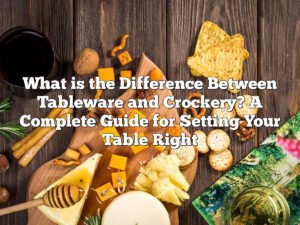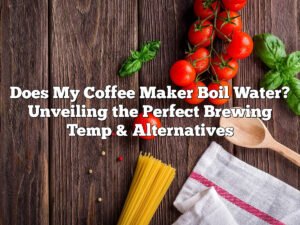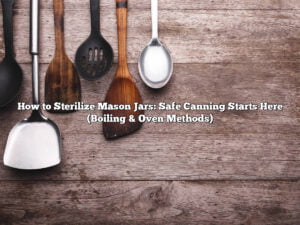Discovering the perfect baking temperature for potatoes can revolutionize your home-cooked meals!
We’ve all been there: you spend time preparing a meal only to end up with potatoes that are either overcooked or still too hard. It’s frustrating to feel like you can’t achieve that consistent, mouthwatering result you crave.
Wonder no more! The ideal baking temperature for potatoes is 425°F (220°C), ensuring a perfectly balanced exterior crispiness and fluffy interior.
As an experienced home cook and food enthusiast, I’m eager to share my expertise on baking potatoes to perfection. In this blog post, you’ll learn about the effects of various temperatures on potatoes, foil usage, and how to master the art of baking potatoes for flavorful, memorable meals. Say goodbye to the guesswork and hello to scrumptious potatoes every time!
Key Facts:
- The optimal baking temperature for potatoes can vary, with recommendations ranging from 350°F to 450°F (Source: Team Research).
- Baking times for potatoes also vary based on temperature and potato size, typically ranging from 45 minutes to 1 hour or more (Source: Team Research).
- Crispy potato skins are achieved by baking at higher temperatures, around 450°F (Source: Team Research).
- Different recipes suggest using temperatures such as 375°F, 400°F, or 425°F for varying durations (Source: Team Research).
- The use of foil while baking can impact the texture and crispiness of the potato skin (Source: Team Research).
Baking Temperature for Potatoes: Finding the Sweet Spot
The ideal baking temperature for potatoes is 400 degrees Fahrenheit. This will cook the potatoes evenly and create a crispy skin. If you want to speed up the cooking time, you can bake the potatoes at 450 degrees Fahrenheit, but they may not be as crispy.

Let’s dive into our journey to find that perfect balance between crispy skins and fluffy interiors!
Selecting the Right Type of Potato
Not all potatoes are created equal! Some varieties are better suited for baking, delivering the perfect texture and flavor when cooked at the right temperature.
Why Russet Potatoes are Ideal for Baking
Russet potatoes are a popular choice for baked potatoes. They have a high starch content, which makes them fluffy and dry when baked. Their thick skin also crisps up nicely at higher temperatures. On the other hand, Yukon Gold potatoes have a lower starch content, making them moist and creamy when baked, but they may not produce that desired crispy skin.
Impact of Potato Size on Baking Time and Temperature
The size of the potatoes will affect the amount of time they need to bake in the oven. Smaller potatoes will cook faster, while larger potatoes typically require a longer baking time and may need an adjustment to the recommended temperature.
Adjusting Temperature and Time for Smaller or Larger Potatoes
For smaller potatoes, bake them at 375°F (190°C) for about 45 minutes. For larger potatoes, bake them at 400°F (205°C) for approximately 1 hour. These are general guidelines, so it’s essential to use an instant-read thermometer to check the internal temperature and ensure doneness.
How Long to Cook Baked Potatoes: Ideal Temperature Range for 350°f, 400°f or 425°f?
There is no one-size-fits-all answer to this question, but I’ve found that 425°F (220°C) is the sweet spot for most potatoes. Baking at this temperature typically creates an ideal balance between crispy skins and fluffy interiors. But don’t shy away from experimenting with different recipes and methods in search of your perfect potato!
Balancing Crispy Skins and Fluffy Interiors
You might need to tweak the temperature based on your personal preference. For example, if you desire even crispier skin, try baking at 450°F (232°C). Keep in mind that adjusting the temperature might also require you to change the baking time. Always monitor the internal temperature to ensure your potatoes are cooked to perfection and not overly dry or undercooked.
To Foil or Not to Foil: The Great Potato Debate
There’s more to baking potatoes than just choosing the right temperature. What about using foil? The decision to wrap (or not to wrap) potatoes in foil can significantly impact the final result. But don’t worry; I’m here to help you make the right choice!
Benefits of Wrapping Potatoes in Foil
Foil-wrapped potatoes are a popular choice for some home cooks. The foil helps retain moisture during the baking process, preventing the potatoes from drying out.
How Foil Affects the Cooking Process
Wrapping potatoes in foil also helps them cook more evenly by distributing heat around the potato. Additionally, foil-wrapped potatoes have softer, more tender skin due to the steaming effect created inside the foil. So, if you prefer a softer, creamier potato, using foil may be the way to go.
Drawbacks of Using Foil
On the downside, if you’re craving that crispy skin, you might be disappointed by the results when using foil. The steamy environment created inside the foil wrap makes it nearly impossible to achieve crispy skin.
Alternative Techniques for Moisture Retention
Instead of using foil, try lightly coating your potatoes with oil and baking them directly on the oven’s rack. This method allows for air circulation and even cooking while retaining some moisture. You can also pierce the potatoes with a fork to release steam, preventing them from becoming too dry.
Baking Techniques for Perfectly Cooked Potatoes
Using the correct baking methods can make a world of difference when it comes to achieving the perfect potato texture. Follow these techniques for a consistent, delicious baked potato every time!
Monitoring Internal Temperature with an Instant-Read Thermometer
Relying on an instant-read thermometer is an excellent way to ensure your potatoes are done to your liking. The ideal internal temperature for a baked potato is around 210°F (99°C), which guarantees a fully cooked, fluffy interior.
Identifying the Perfect Temperature for Doneness
Using a thermometer is especially helpful when you’re baking multiple potatoes of varying sizes. You can also use a thermometer to fine-tune your preferred doneness, ranging from a slightly firm potato at 205°F (96°C) to a very soft potato at 215°F (102°C).
Baking Potatoes Directly on the Oven Rack for Even Cooking
One simple trick that improves the overall texture of your baked potatoes is baking them directly on the oven rack. This method allows for better air circulation and heat distribution around the potatoes, resulting in an evenly cooked potato with a crispy skin.
Enhancing Air Circulation and Heat Distribution
Placing a baking sheet underneath the potatoes on a lower oven rack can catch any potential drippings and make cleanup a breeze.
Alternative Cooking Methods for Baked Potatoes
In addition to the classic oven-baked method, there are other techniques you can use to create delicious baked potatoes.
Fast Baking: How To Cook Baked Potatoes in The Oven Quickly
In a hurry? No problem! To cook your potatoes faster, cut each potato into smaller pieces before baking. Doing so shortens the cooking time and ensures you can enjoy a baked potato even on a busy evening.
Baked Potatoes in the Air Fryer: A Modern Twist
The air fryer has become quite popular in recent years and is another excellent method for baking potatoes. Air-fried potatoes can be cooked in less time at a slightly lower temperature than conventional oven-baked potatoes and still achieve a delightful crispy skin.
Benefits and Drawbacks of Air Fryer Baked Potatoes
Air fryers use hot air circulation to cook food quickly and evenly while using less fat. The primary advantage of using an air fryer over an oven is the speed at which it cooks potatoes. However, keep in mind that most air fryers have limited capacity, so if you need to cook larger quantities, the oven might still be your best bet.
FAQs About Baking Temperature for Potatoes
What temp should baked potatoes be cooked at?
The ideal baking temperature for potatoes is 425°F (220°C) for a balance of crispy skin and fluffy interior.
Is it better to bake a potato at 350 or 400?
While 350°F (177°C) or 400°F (205°C) can be used to bake potatoes, 425°F (220°C) is typically the ideal temperature for most potatoes, assuming you want a crispy skin and fluffy interior.
How long does it take to bake a potato at 400?
Baking time can vary depending on the size of the potato, but a large potato typically takes about an hour at 400°F (205°C).
How long will potatoes take at 350?
At 350°F (177°C), a large potato will take approximately 90 minutes to cook fully. Keep in mind that cooking time might vary based on the potato’s size.
How Long to Microwave a Baked Potato
For a medium-sized potato, start with 7 minutes on high power, turning the potato over halfway through cooking. If the potato is not fork-tender after 7 minutes, continue microwaving in 1-minute increments until it is done.
Summary
Mastering the art of baking potatoes can elevate your meals and impress your family and friends. By understanding the ideal baking temperature for potatoes, experimenting with foil usage, and trying different cooking methods, you’ll be well on your way to creating the perfect potato every time.
So, grab your oven mitts and get ready to enjoy delicious, perfectly baked potatoes that will have everyone reaching for seconds! And remember, this is just the beginning of your journey to becoming a potato-baking master, so continue to explore and experiment to find your ideal technique. Happy baking!





